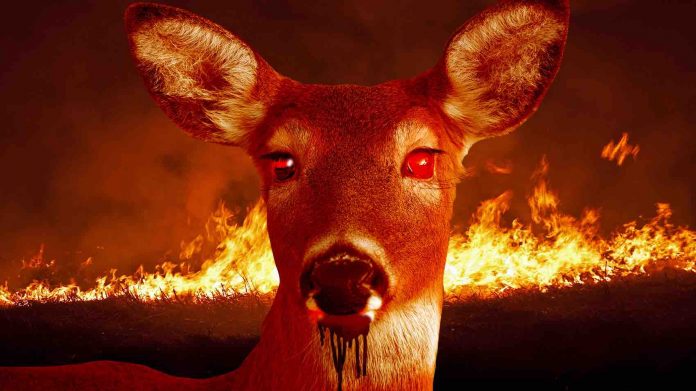Up until recently, the zombie apocalypse was nothing more than a fictional depiction drawn out in Hollywood movies.
However, a strange and deadly disease turning deer into zombies has been sweeping across North America, leaving people wondering – is the end extremely fucking nigh?
Some experts seem to think so, claiming that the so-called Chronic Wasting Disease currently affecting deer, elk and moose in 24 states and two Canadian provinces could very well spread to humans in the years ahead.
The virus itself attacks the brain, spinal cord and tissues of the animal infected, causing aggressiveness, loss of concentration, drooling, lack of fear of people and listlessness. The phenomenon has been the talking point of late as it continues to sweep across North America.
Although we were previously reassured that the disease is nothing we should be scared of, this week, Michael Osterhold – director of the Center for Infectious Disease Research and Policy at the University of Minnesota – issued a warning to his state lawmakers about the impact CWD could have on humans.
As reported by USA Today, he said: “We are in an unknown territory situation. It is probable that human cases of chronic wasting disease associated with consumption with contaminated meat will be documented in the years ahead.
“It’s possible the number of human cases will be substantial, and will not be isolated events.”
Osterhold went on to liken the illness to that of Mad Cow disease, which had a major effect on agriculture in the UK during the 80s and 90s and wound up killing nearly 160 people.
The Centers for Disease Control and Prevention said that eating deer meat would be the likeliest way for humans to contract CWD, with an estimated 7,000 to 15,000 infected animals consumed each year by Americans.
Although there’s no definite answer as to whether this will cause a human crossover, Osterholm says the likelihood will increase, a view which was bolstered by recent observations that macaque monkeys could catch it from eating the meat. He described it as ‘a throw at the genetic roulette table’.
CWD was actually observed in the wild around four decades ago, with the CDC’s report on it stating: “Since 2000, the area known to be affected by CWD in free-ranging animals has increased to at least 24 states, including states in the Midwest, Southwest, and limited areas on the East Coast.
“It is possible that CWD may also occur in other states without strong animal surveillance systems, but that cases haven’t been detected yet.”
Now the disease is spreading further afield as more and more people report cases of infected animals.
“People have to understand the significance of this. We can’t wait until we have the first cases coming,” concluded Osterholm.








